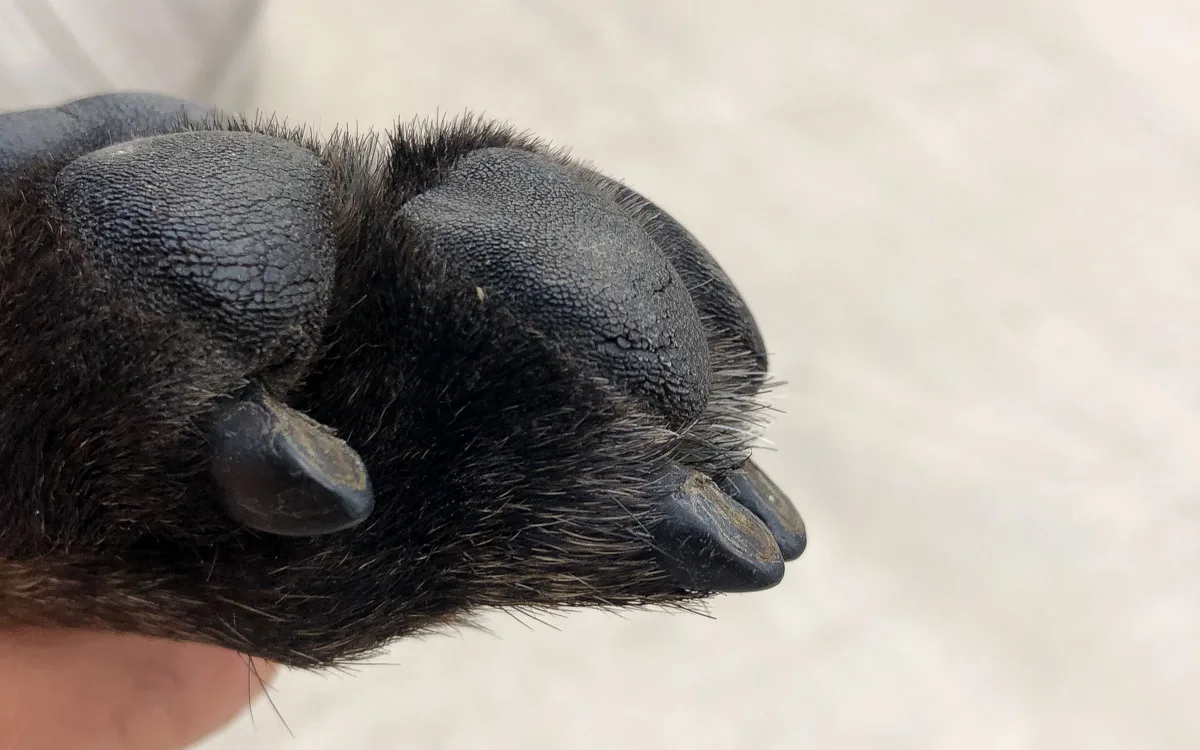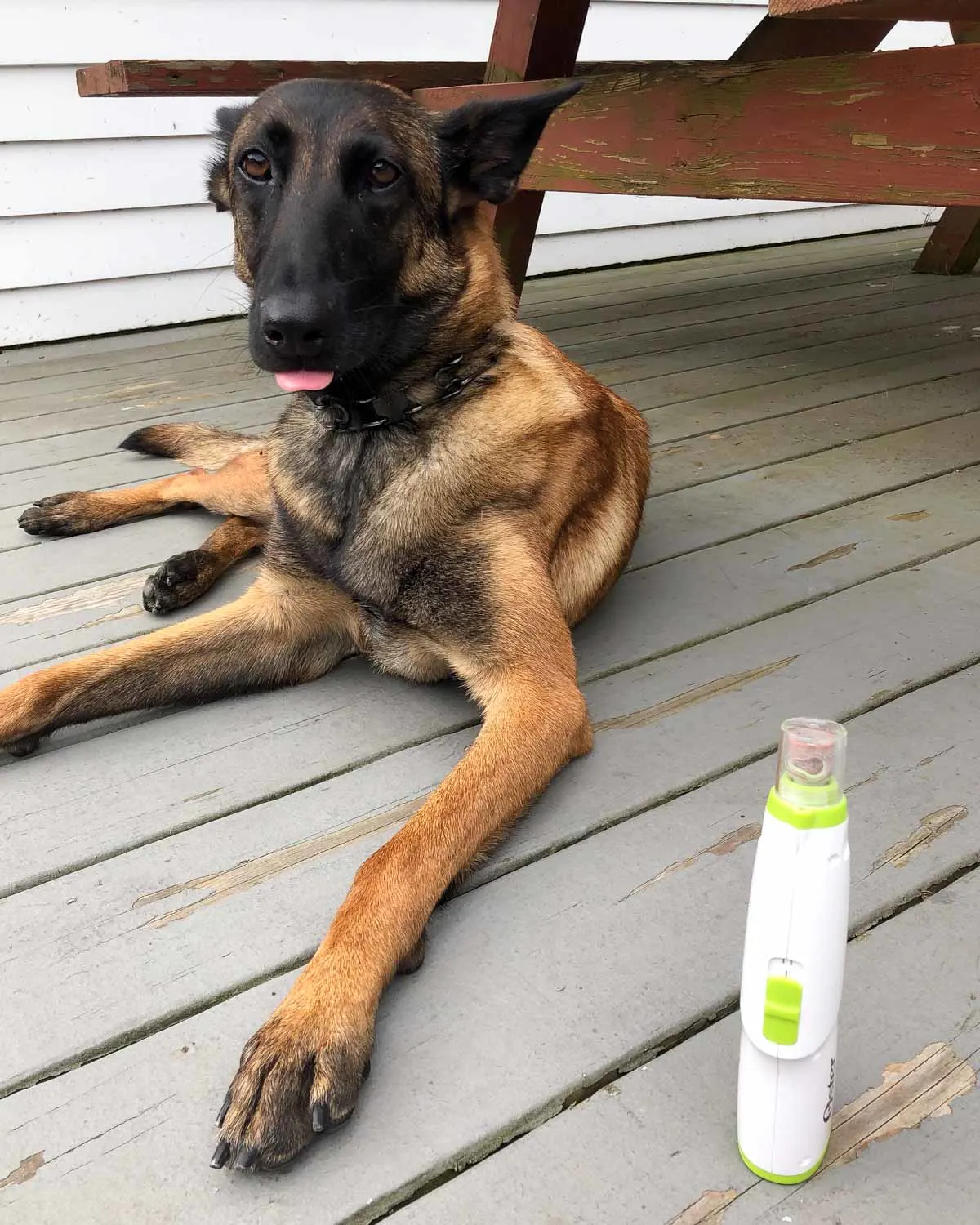Trimming your furry friend’s nails can be a daunting task, especially when they have dark nails. The fear of cutting too close and causing pain can be nerve-wracking. But with the right approach and some expert guidance, you can confidently and safely trim your dog’s black nails, ensuring their comfort and paw health.
Long nails can lead to arthritic joints in the toes and wrists and can also curl up into the paw pads, penetrating the skin causing pain, infection and abscessing. In this guide, we’ll walk you through step-by-step instructions and valuable tips for a stress-free nail trimming experience.

This post may contain affiliate link(s). As an Amazon Associate, I earn from qualifying purchases.
Understanding black nails
Cutting black dog nails can pose a challenge because the quick, the blood vessel within the nail, is harder to see compared to lighter nails. The “quick” is the sensitive part of the nail that contains blood vessels and nerves. You can easily identify a dog’s quick if your dog has clear nails, as you will see a distinct difference between the casing of the dog’s nail which is lighter in color and the blood supply in the quick which is darker.
For dogs with black nails such as the Belgian Malinois and Dutch Shepherd, it will be more difficult to locate the quick. This increases the risk of accidentally cutting the quick, which can lead to pain and bleeding. The “casing” or “shell” is the part of the nail that should be trimmed. It is the part that extends from the quick to the tip of the nail. Understanding the anatomy of the nail and the quick’s position is crucial before you start.

Tools you will need for cutting black dog nails
Gather your tools before you begin. Some different types of clippers include:
- Guillotine clippers — These dog nail trimmers have a hole that you poke the nail through. The cutting edge usually remains sharp leading to fewer splintered edges on the nail.
- Scissor-style clippers — These look like small scissors with angled divots toward the end of each blade so you can view the cutting area. These are best for small dogs and puppies.
- Plier-style clippers with safety guard — Look similar to scissor-style clippers, but they have a spring and they are stronger and better for large, thick nails. The safety guard can prevent excessive trimming
- Nail grinders — These are like a Dremel and they file your dog’s nails smoothly and precisely which also makes it harder to accidentally cut the quick.
You’ll need a pair of high-quality dog nail clippers or grinders, styptic powder (in case of bleeding), and treats to reward your pup’s cooperation.
Our personal preference for cutting black nails on a dog is using a grinder as it offers more control during the process making it easier to trim the nails without nicking the quick. If you condition your dog to it, they can really enjoy the process.

Conditioning a dog for nail cutting
The first step is to condition your dog to be tolerant of you handling their feet. Utilize positive reinforcement and always make it pleasant and rewarding anytime you touch their feet by simultaneously or immediately thereafter rewarding with a high value food reward.
The next step is to gradually introduce your dog to nail clippers or a grinder. Let them sniff and investigate the tools while simultaneously associating the tool with a food reward. The other important step is to find a location and a position you intend to use while cutting your dog’s nails.
For me, it is having my dog laying belly up on the floor in between my legs while I’m sitting down against a wall. This position gives me stable access to all four legs.
When I initially set the dog into this position I will lure them with my secret weapon, a spoon dipped in peanut butter or almond butter. I use a spoon versus a lick pad on a wall so I can eventually control the dispensed amount of reward and reinforce the behavior per paw.
While in the seated position, I will reward the dog with a lick of the peanut butter. Then while they are in position I will turn the grinder on for about three seconds while I give them another lick of the peanut butter.
As long as they stay calm I will mark the behavior and reward with a treat while they are calm. It’s important to immediately release them from the position in the beginning. I gradually build a longer duration before rewarding them with a treat and releasing. All this is done before ever cutting a single nail.
Don’t rush this step, it is the foundation of having a calm, stress free grooming session. A study published in Sciencedirect showed that nail trims can be a stressful experience for dogs. If proper conditioning isn’t established in the beginning, you may end up with a situation where your dog needs to wear a muzzle and be taken to professionals for regular nail cutting.
Examine the nails
Observe the nails in a well-lit area. You will find it difficult, if not impossible, to identify the quick on a black nail so you will need to look for other characteristics. Depending on the length of the nail, look to see if the nail is hooking downward or touching the floor.
If it is, look for where the tip of the nail meets the “sole”. The “sole” is the underside of the nail and generally curves inward. I will generally start by removing the tip of the hook slowly to where it meets the sole.

Trimming black dog nails
If using clippers, make small cuts, avoiding the quick. If using a grinder, gently grind the tip of the nail in a controlled manner, periodically checking the quick’s location.
Trim the nail at 45 degrees so that the flat cut will be parallel to the floor as the dog is standing. Remember to start off with small amounts while continuously checking the cross-cut section of the nail for signs of the quick.
Start out with one paw at a time, rewarding with a lick of the peanut butter for each nail I complete. Once that paw is done, take a break and allow some fun free time before moving on to the next one.
Once you’re satisfied with your trim you can also smooth the edges of the nail to prevent splintering or discomfort. If you begin to see a light gray circle in the face of the nail you are cutting you will want to stop. If you go too far and nick the quick, don’t panic just be ready with the next step.
Cutting the quick
If you accidentally nick the quick it may or may not hurt your pet depending on how far you penetrated the blood vessel. The more quick that’s cut, the more nerves are damaged which can lead to more pain.
You may see your pet pull their paw away if their quick is cut while some may also whine. For small injuries, the bleeding won’t last much past a few minutes for most dogs but nevertheless, it’s something you will want to avoid so your dog doesn’t develop a negative association with nail trimming.
Hope for the best but plan for the worst. Having something like styptic powder or even corn starch on hand is a good idea so you can stop the bleeding in the event you trim too much off the nail. In our experience, this rarely happens with a grinder and seems to happen more often with clippers.

Tips for success
- Go gradual — Trim a little at a time. It’s better to take multiple sessions than risk cutting too much at once.
- Be patient — If your dog is nervous, take your time and provide reassurance.
- Stay calm — Your energy affects your dog. A calm and composed demeanor will help keep them relaxed.
- Have styptic powder handy — Accidents can happen. Styptic powder helps stop bleeding in case you accidentally cut the quick.
- Seek professional help — If you’re unsure or uncomfortable, consult a veterinarian or a professional groomer.
Cutting black dog nails may seem challenging, but armed with knowledge and patience, you can conquer this task. Regular nail maintenance is vital for your dog’s comfort and health.
Remember, practice makes perfect, and your pup will appreciate your efforts to keep their paws in tip-top shape. Happy trimming!
Watch the web story — How to cut black dog nails.

